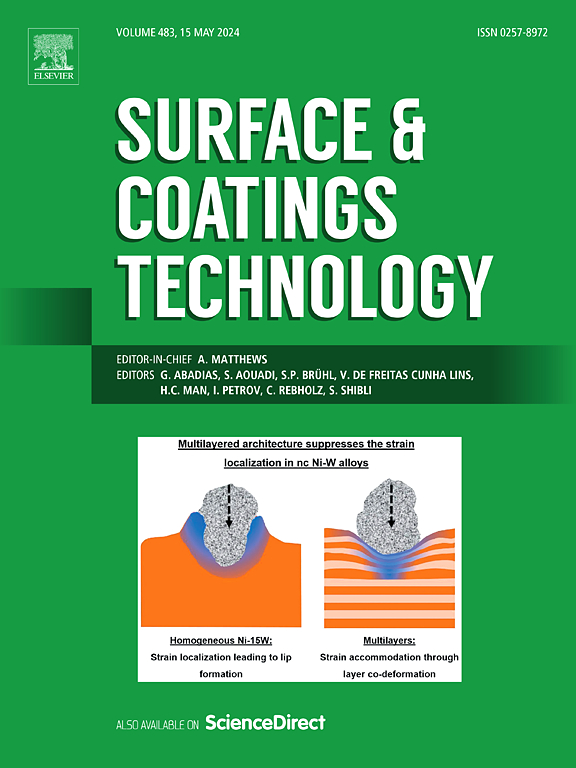Microstructure and wear resistance of environmentally friendly NbC-FeCr coatings: An evaluation of HVOF process parameters
IF 5.3
2区 材料科学
Q1 MATERIALS SCIENCE, COATINGS & FILMS
引用次数: 0
Abstract
Health risks of Co and classification of W and Co as critical raw materials are currently the driving forces behind the search for WC-Co(Cr) replacement. NbC-based hardmetal compositions have just recently emerged and are now under consideration for use as thermally sprayed wear resistant coatings. NbC is proposed to be particularly suitable for combination with Fe-based binders. In this study an agglomerated and sintered 80NbC-15Fe5Cr (wt.-%) powder was processed by means of liquid-fueled HVOF. The experiments were carried out in two series: The influence of spray distance (305 and 395 mm) and nozzle geometry (lengths of 150 and 200 mm with diameters of 11 to 14 mm) were investigated in the first series. Powder feed rate (77 to 114 g/min) and oxygen-fuel-ratio (λ = 1.0 and λ = 1.2) were varied in the second series. In-flight particle velocity of approximately 700 m/s and temperature of 2150 °C resulted in coatings of the highest quality achieved in this study. SEM and optical microscopy of the coatings showed a higher thickness with higher in-flight particle temperatures and porosities between 2.1 and 4.6 %. XRD and EDS analyses revealed the presence of oxygen as FeNb2O6. Strongly correlated with porosity, Vickers microhardness ranges from approximately 770 to 900 HV0.3. Unidirectional and reciprocating dry sliding wear rates of 1.2 × 10−6 and 2.1 × 10−6 mm3/(N × m), respectively are fully competitive to those of the reference coating systems WC-CoCr and Cr3C2-NiCr. Overall, the shorter spray distance with a smaller nozzle was advantageous when combined with λ = 1.0 and powder feed rate of 102 g/min.
环境友好型NbC-FeCr涂层的微观结构和耐磨性:HVOF工艺参数的评价
Co的健康风险以及W和Co作为关键原材料的分类是目前寻找WC-Co(Cr)替代品的驱动力。基于nbc的硬质合金组合物最近刚刚出现,现在正在考虑用作热喷涂耐磨涂层。建议NbC特别适合与铁基粘合剂结合。采用液体燃料HVOF对80NbC-15Fe5Cr (wt.-%)粉末进行了烧结团聚处理。实验分两个系列进行:第一个系列研究了喷射距离(305和395 mm)和喷嘴几何形状(长度为150和200 mm,直径为11至14 mm)的影响。在第二系列中,粉末进料速率(77 ~ 114 g/min)和氧燃料比(λ = 1.0和λ = 1.2)变化。在大约700米/秒的飞行粒子速度和2150°C的温度下,获得了本研究中最高质量的涂层。扫描电镜和光学显微镜观察表明,涂层厚度较高,飞行温度较高,孔隙率在2.1 ~ 4.6%之间。XRD和EDS分析表明,氧以FeNb2O6的形式存在。与孔隙度密切相关,维氏显微硬度范围约为770 ~ 900 HV0.3。单向和往复干滑动磨损率分别为1.2 × 10 - 6和2.1 × 10 - 6 mm3/(N × m),与参考涂层体系WC-CoCr和Cr3C2-NiCr完全竞争。综上所述,当λ = 1.0,给粉速度为102 g/min时,喷嘴尺寸越小,喷雾距离越短。
本文章由计算机程序翻译,如有差异,请以英文原文为准。
求助全文
约1分钟内获得全文
求助全文
来源期刊

Surface & Coatings Technology
工程技术-材料科学:膜
CiteScore
10.00
自引率
11.10%
发文量
921
审稿时长
19 days
期刊介绍:
Surface and Coatings Technology is an international archival journal publishing scientific papers on significant developments in surface and interface engineering to modify and improve the surface properties of materials for protection in demanding contact conditions or aggressive environments, or for enhanced functional performance. Contributions range from original scientific articles concerned with fundamental and applied aspects of research or direct applications of metallic, inorganic, organic and composite coatings, to invited reviews of current technology in specific areas. Papers submitted to this journal are expected to be in line with the following aspects in processes, and properties/performance:
A. Processes: Physical and chemical vapour deposition techniques, thermal and plasma spraying, surface modification by directed energy techniques such as ion, electron and laser beams, thermo-chemical treatment, wet chemical and electrochemical processes such as plating, sol-gel coating, anodization, plasma electrolytic oxidation, etc., but excluding painting.
B. Properties/performance: friction performance, wear resistance (e.g., abrasion, erosion, fretting, etc), corrosion and oxidation resistance, thermal protection, diffusion resistance, hydrophilicity/hydrophobicity, and properties relevant to smart materials behaviour and enhanced multifunctional performance for environmental, energy and medical applications, but excluding device aspects.
 求助内容:
求助内容: 应助结果提醒方式:
应助结果提醒方式:


